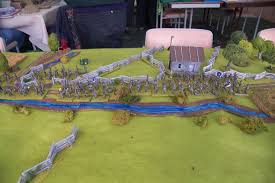July is our clubs annual ACW
and mid-19th century bash where a few of us roll out our games for
two days of gaming in the period.
Boyd, Rich, John, Dave, Mat
and I played two games of 28mm ACW using Jonny Reb III rules over the two days.
On the First day we played a
little round top scenario by Scott Mingus. Boyd and Richard commanded the Union,
the confederates were commanded by John and I. The Confederate attack had early success when
John’s long range shooting caused a number of casualties on the unit beside the
20th Maine, who fell back in disorder, the confederates moved
forward and received and gave moving fires for two turns, the union
sharpshooters commanded by Richard really whittled down the confederates so
much that one Confederate Regt failed morale and ran off the table leaving the
others to continue the assault, mostly cracking rolling by Richard (by the 20th
Maine) seen another off triggering a Brigade Morale test which I promptly
failed….1s pick up remainder of brigade….the
follow up brigade fared no better and the game ended around 2pm, time to set up
for the next day!
The second day Boyd, Richard
and Dave commanded the Union against, the confederate commanders John, Mat and
I. The game was a fictional game
based on a counterattack by the union against the tired Confederate centre
around the Wheatfield’s along Plum Run on the second day of Gettysburg.
The Confederates had a +1 disadvantage
to all morale rolls, which is ok early but once the casualties start…….. The
Union had a +1 firing modifier which really tolled if they rolled well. The
Union were a little worried as they advanced
but their artillery done great damage on a number of units, one battery
actually rolled all sixes and all but wiped out a small 12 figure batn, who
promptly routed and took one other with them in the process, leaving a gaping
hole between two brigades. The union advance on the right was extremely
successful with two confederate batns totally destroyed and two others routing
leaving a gaping hole in the line, the union were finally blunted and Johns
troops counterattacked which was quite good to see, whoever the entire left
flank of the confederates collapsed after two batns routed and the remainder of
the brigade become shaken and then finally routed, this caused morale rolls all
through my brigade which became shaken and finally routed leaving the hill and
the fields to the union troops…….must get myself some new dice I think!
 |
On Sunday a second game ran
behind us with around ten players playing a Kriegspiel wild west game, that
always seemed on the edge of anarchy! The town was aptly named “Profanity.” My
favourite recollections coming from that general direction;
Cowboy Player “ I’m going for
a long range snap shot”
Gamemaster “ well it is
extreme range and there are Mexican civilians in the way”
Cowboy player “ that’s ok”
Gamemaster rolls dice
Cowboy Player “I am going to
hide in this building”
Gamemaster “it’s on fire”
Cowboy Player “that’s fine”
Player “damn Pinkertons, how
come they shoot so well”
Gamemaster “well they aim,
they are using rifles, and you are on you galloping horse, with a pair of
pistols trying to shoot up to a two story window with a verandah in the way”
It was as funny as it sounds…….
Day two union assault a confederate siege gun position, rules JonnyReb III
 |
 |
Cheers
Matt























.jpg)





